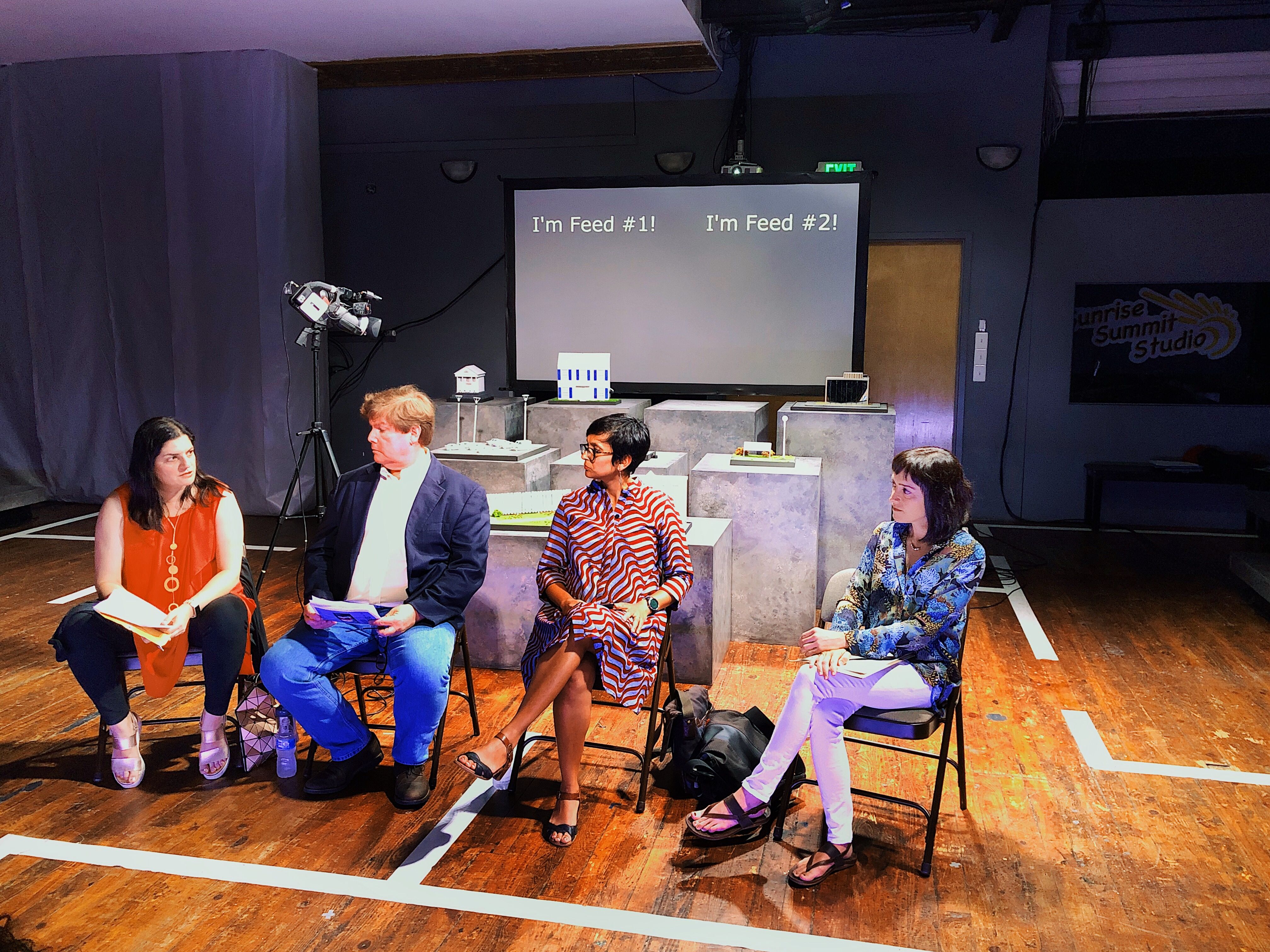Crowded around the Dance Loft on 14 off a side street in the Petworth neighborhood, theatre goers and art lovers alike settled in to watch a play that has received a lot of acclaim in its few short weeks of performance. Forest Treàs (pronounced “triage”) is the story of a small fictional D.C. neighborhood during the “Beltway Sniper” attacks of 2002, which resulted in the loss of many innocent victims at random over three weeks. The original play is produced by Pointless Theatre Compnay and written by Naveed Azeez. The residents of Forest Treás grapple with the media, the new “24 hour news reel” phenomenon and what precautions to take to keep everyone safe. The play goes on to explore how invasive the news can feel in times of crisis, what angle journalists should take when reporting on mass violence, and the balance that people struggle to find when coping with fear and trauma.
In partnership with Pointless Theatre, the Pulitzer Center conducted a conversational panel before the June 14th performance to explore topics covered within the show. Moderated by Executive Editor Indira Lakshmanan, the panel explored the challenges of covering mass shootings and the ethics that journalists grapple with when covering mass violence. Joining Lakshmanan were Pulitzer Center grantees Rhitu Chatterjee and Allison Shelley, as well as freelance photojournalist Rod Lamkey Jr.
Lamkey Jr., Chatterjee and Shelley all spoke to their own experience as journalists and how they have been affected by the stories they’ve covered throughout their careers. Lamkey Jr, who covered the DC sniper shootings as a staff photojournalist for The Washington Times, described the fear that came with covering the story: “ Everybody, the public [and] us as well, were just fundamentally scared. Just because you have a camera doesn’t mean that you won’t get shot… You could just be going to Safeway, and that’s it.”
When asked about the media's responsibility to divulge the entire scope of a story or to not terrorize communities during times of crisis, Lamkey Jr. responded “we have a lot of responsibility to tell people what’s going on. Hopefully people can find a way to keep perspective."
Shelley also shared a unique perspective from her experience as one of many journalists who documented the Virginia Tech Shootings in 2011. She described the flocking of the media to the university the day after the violence occurred, saying “within 24 hours there was already hundreds of us there.” During the candle vigil in the days following the shooting, Shelley detailed the breakdown of attendees and how this moment changed the way she viewed herself as a journalist: “To the several thousand people, [there was] several hundred media. It really brought me deep into thinking about what’s on the other side of the camera.”
In addition to the experiences of being a journalist during times of mass shootings, Lakshmanan asked Chatterjee to share her background as a health correspondent for NPR, and how it has influenced her understanding of those who commit mass violence. Chatterjee described her reporting on research that has been done about the psychology of people who perpetrate mass violence. “What person in their right mind decides to do something like this?”, Chatterjee posed to the crowd, “There are multiple layers of risk factors…that put someone on the path to violence.” Chatterjee explained that there is a “huge overlap of suicide and mass shootings…[they] are so upset and angry with themselves that they start…wanting to die, and [they] want to take people down with them.”
Chatterjee explained that the Beltway Sniper was not the first mass shooting, but that it was unique because it was one of the first instances of a mass shooting that had 24 hour live national coverage. Particularly discussed was the shooting at Columbine High School in 1999. Lakshmanan posed the idea of the "contagion effect" stemming from this instance of violence, a phenomenon that can be best described as the quick nature in which mass violence occurs after one act of mass violence has occurred.
Chatterjee explained that researchers have found the shooting at Columbine High School to be the event that went on to inspire other people to commit mass violence at other centers of education. Chatterjee spoke specifically to the Marjory Stoneman Douglas High School shootings in 2018, where the perpetrator was found to have had many diaries about Columbine. She also explained that some researchers propose that mass violence could be prevented through more comprehensive coverage of the mental health issues that many perpetrators of mass violence deal with and ways to treat mental health issues.
“We have to give young [shooters] empathy or we fail all of them,” she said. She acknowledged that this will be difficult, but explained that assessing the feelings and thoughts of shooters can lead to mental health supports that would prevent violence from happening again.
The conversation then shifted to the final topic for the panel: How should journalists cover the perpetrators of mass shootings? Shelley suggested that there should be more coverage on the lasting impacts of mass violence. “Newspapers cover perpetrators 16% more than the victim… [that’s the] balance of what we’re putting in our newspapers," she said.
Lamkey Jr. said that many journalists are turning their focus to the victims of violence rather than the perpetrators. He added that police are also becoming more careful about how much information is shared about the perpetrators of violence. He cited a recent shooting in Virginia Beach as an example.
Lakshmanan questioned whether this new trend was a positive change from previous in depth reportings about the perpetrators of these acts of violence. Lamkey Jr. responded that he did believe it was a good thing.
He went on to talk about the ethics he believes that photojournalists should follow when covering mass shootings. “There is always the gravity to keep in mind, lots of material is graphic and there must be sensitivity,” he said, adding that he believes it would be unethical to photograph the faces of those who have died as part of a mass shooting.
Lakshmanan examined whether or not the media is “sanitizing” tragedy and if it would be more effective to show the more graphic photos to the public so that people feel compelled to seek change that would prevent future attacks.
"No, it’s a disservice to the victims," Lamkey Jr. responded. "That feeds into the shooters energy… [almost like] they’ve won.”
After the panel, actors took the stage with cameras pointed at the audience to begin their performance of Forest Treás. The hour and 30-minutes that followed was an astounding narrative about this tiny fictional town and how it handled all of the content above. More information about Forest Treàs and Pointless Theatre can be found here. The panel was supported by a grant from the D.C. Commission on the Arts and Humanities, which receives support from the National Endowment for the Arts.


